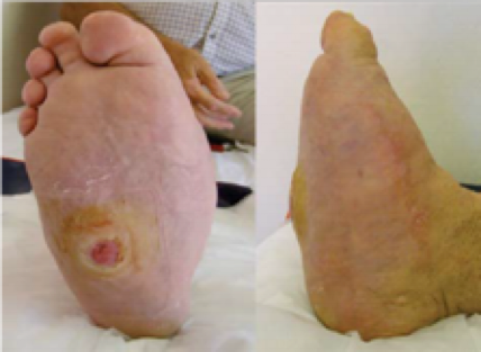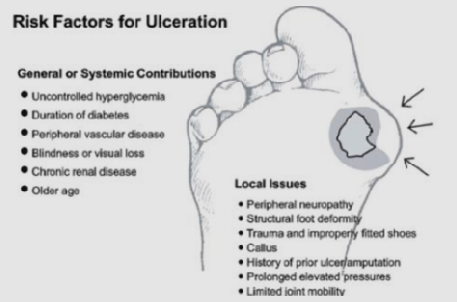DIABETES & FOOT
CONDITIONS
Foot complications account for more hospital admissions than any other diabetic complication. The two major conditions are Charcot foot and diabetic foot ulcers. Because of their potentially serious consequences (in the worst cases, amputation of the foot or toes), it is imperative to seek treatment as early as possible.


Charcot Foot
Charcot foot is probably the most critical foot problem that can develop as a consequence of diabetes. Poor circulation and nerve damage can lead to a weakening of the bones in the foot, and, as the disorder progresses, the joint may collapse. Charcot foot is a serious condition that can lead to severe deformity.
Diabetic Foot Ulcers
It’s usually a combination of problems rather than a single risk factor that causes diabetic foot ulcers. These include nerve damage (peripheral neuropathy), peripheral vascular disease, foot deformities (claw toes), fluid retention (peripheral oedema) and external trauma. In Western countries, the most common cause of trauma is inappropriate footwear.
What is Diabetes?
Diabetes is a chronic and complex condition, which can affect the entire body. For our bodies to work effectively, we need to convert glucose (sugar) from food into energy. A hormone called insulin is essential for the conversion of glucose into energy. In people with diabetes, insulin is no longer produced or not produced in sufficient amounts by the body.
Type 1 Diabetes?
Type 1 diabetes is an auto-immune condition in which the immune system is activated to destroy the cells in the pancreas that produce insulin. It is managed through daily insulin injections, a healthy lifestyle and regular blood glucose testing, which can minimize associated complications.
Type 2 Diabetes?
This is the most common form, affecting 85-90% of all people with diabetes. In type 2 diabetes, the body is unable to properly regulate the amount of glucose in the blood. It is caused by a variety of genetic and environmental factors including poor diet, obesity, insufficient physical exercise and high blood pressure. Type 2 diabetes can be initially managed with lifestyle modifications: healthy eating, regular exercise and blood glucose monitoring. However, as the disease progresses, patients are often prescribed additional medication.
Complications of Diabetes
Ineffective management of diabetes can lead to damage to the body over time. Common complications involve:
- Eyes
- Feet and hands
- Kidneys
- Impotence
- Heart and blood vessels
- Gum disease
CHARCOT (DIABETIC) FOOT
Symptoms of charcot foot or joint are:
- Mild to severe swelling
- Inflammation
- Erythema
- Joint effusion
- Bone resorption
- Loss of sensation.

